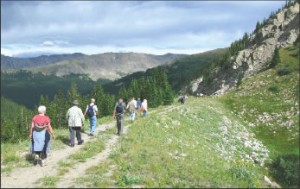(Editor’s note: In our June issue we ran two articles by Denver author Keith Howard on the artists Christo and Jeanne Claude. One of our readers, who is opposed to the project proposed for the Arkansas River, Over the River, asked if we would reprint the following editorial from the editor of Landscape Architecture magazine offering his viewpoint.)
Environmental artists Christo and Jeanne-Claude want to cover up a white-water river in the Rocky Mountains with 5.9 miles of silvered cloth. Should the people of Colorado let them do it?
That’s right: the environmental art duo who brought us Running Fence in California and The Gates in New York City now have their eyes on Bighorn Sheep Canyon, a stretch of the Arkansas River known for its wildlife, fishing, and white-water rafting. You can view their concept drawings at www.overtheriver.org. The project will cover the Arkansas River with 5.9 miles’ worth of “fibrillated polypropylene fabric coated with vaporized aluminum on both sides.” These translucent canopies will hover eight to 25 feet above the water and reach almost bank to bank.
Some Coloradans who live near the canyon are up in arms about the project and have formed a group called ROAR (Rags over the Arkansas River). They charge that the influx of hundreds of thousands of tourists will create a traffic nightmare on the two-lane canyon; that the drilling required to fasten the panels will permanently deface the riverbanks; that bighorn sheep, elk, deer, and other wildlife will be kept from their drinking water; and that eagles and sports fishermen won’t be able to fish the river. And, although the panels will only be in place for two weeks, Christo admits that installation and removal will disrupt the area for two to three years.
Although I’m a fan of good environmental art, I’m going to side with ROAR on this one. Some of Christo and Jeanne-Claude’s work – most recently, The Gates in Central Park – has been widely praised. Many landscape architects who visited it said that The Gates framed Frederick Law Olmsted’s master work in a way that let them see it with new eyes. Over the River seems to be doing quite the opposite – it actually covers up the river. Does anyone, even Christo, think 5.9 miles of silvered fabric is anywhere near as beautiful as a free-flowing mountain river?
Then there’s the question of what to do with all those miles of fibrillated polypropylene fabric after the project closes. We’re told it will be recycled, but what does “recycling” mean for these extravaganzas? After The Gates was dismantled, the orange vinyl from which the 7,503 gates were made was refashioned into tiny orange rulers. I happen to be the recipient of one. I have no idea how I’d ever use it. Is that meaningful recycling?
Conceived in the early 1990s or before, Over the River is a conceptual and environmental dinosaur, a relic from the days when some land artists and designers aspired to create iconic art without regard to the environmental cost. As the Washington Post said of Over the River: “There’s a sense this kind of 1970s-era ‘environmental art’ has more links to heavy industry – to old-fashioned well drilling and dam building – than to some more recent art that’s been made with genuine ecological feeling.”
As other, better artists strive to create a greener future, what should environmental art look like?
J. William “Bill” Thompson, FASLA Editor / Landscape Architecture magazine, April 2009. Reprinted by permission of the author.


